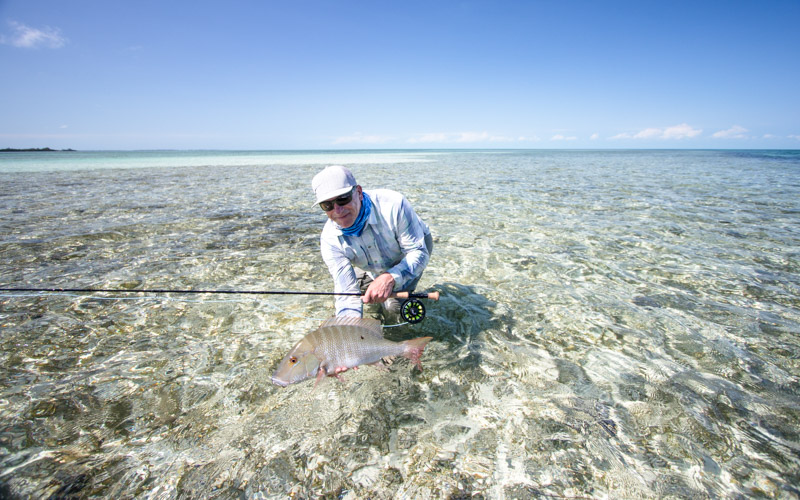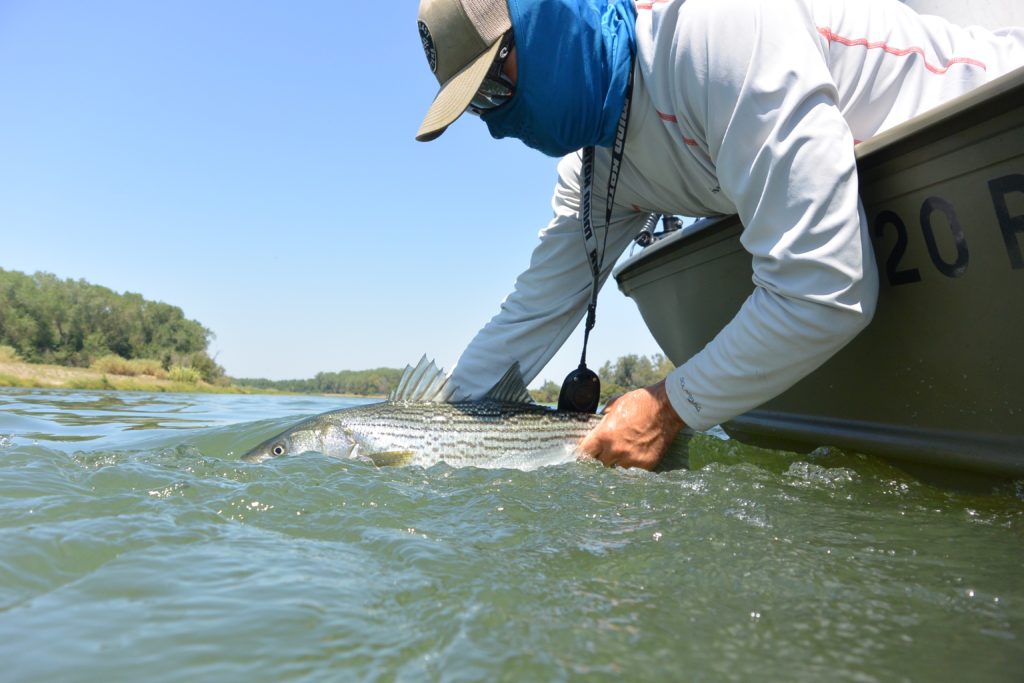By Tyler Justice Allen
(originally published in Tail #30 – July/August 2017)
Humans, like fish, are fickle creatures. We have certain proclivities and idiosyncrasies, both defined and obtuse. There are some things we can take, and some things that we just can’t.
I love to fish, but a banana in my boat will ruin the day – regardless of my client’s protests or potassium deficiency. “Hop in that guy’s boat, then,” I say, not willing to give the banana a chance. Why do I have such a vendetta against water-borne bananas? If I knew, I’d tell you. It’s just one of my ‘things’.

Bonefish and tarpon have their ‘things’. Rockfish and other cold salt species have a few. Permit are the very definition of ‘picky’, but you already knew that. When it comes to fish handling and sensitivities specific to particular species, it pays to do your homework. Many proactive fishing handling practices can be applied across species to great effect; others are only impactful to a handful of taxa. Below are guide-tested guidelines for minimizing angling’s impact on caught fish in various marine environments. The more suggestions you’re able to employ, the better poised we’ll be to support sportfishing’s longevity.
Tarpon (Megalops genus)
This big-eyed denizen of the flats is numero uno on most anglers’ bucket list. Capable of incredible runs, tarpon are famed for long fights and breaking hearts. If you have to ask yourself whether you spooled up enough backing before a tarpon trip, the answer is going to be ‘not even close’. Despite tarpons’ size and power, the IGFA maintains records for fish caught on tippet down to the #2 class. That record? 106 pounds, zero ounces. That fish? Not in good shape after landing. While there isn’t any credible record of the fight time, landing a fish of that magnitude (in any sort of real ‘sporting’ manner) on #2 tippet would require total exhaustion on the fish’s part. Total exhaustion opens the door for now-incentivized predators, including bulls and hammerheads waiting for an easy meal. Considering the state of many of our fisheries, fishing adequately-rated tippet is the least we can do as anglers. It’s important to learn to gauge a tarpon’s exhaustion during the fight. It takes practice, but it’s worth the effort. If you’re able to approximate how tired the fish is (an inexact science, certainly), you can know when it’s time to put the wood to ‘em without breaking off or ending up with a damaged fish on the line.
Bonefish (Albula genus)
Bonefish reside in temperate waters worldwide, though most are found near the tropics. The species most often targeted by North American anglers, Albula vulpes, is the quintessential flats fish: smart, spooky, and built for speed. For those who have brought bonefish to hand, their defining characteristic is something less romantic. A thick coating of mucus covers the fish from stem to stern, making them exceedingly hard to hold onto, a helpful trait in predator-filled waters. This slime layer also plays a similar role to the mucus found on most fish, acting as a protective barrier against parasites and pathogens. The slime contains antibodies, antimicrobial peptides, and enzymes that actively break down pathogens that would otherwise attack the fish, though the exact composition varies from species-to-species. When a bonefish’s slime is removed by rough handling or other abrasion, it’s less able to repel these ne’er-do-wells. Keeping hands wet and fish away from clothing is the best way to prevent slime loss when releasing bonefish. Gunnel rails don’t do much for slime, either. Bonefish that don’t calm down after being brought to hand can be charmed into submission by turning them over onto their backs as the hook is being removed, ideally leaving the fish’s gills below the waterline during the process.
Anecdotal evidence suggests that predators cue in on fish whose slime barrier has been damaged. The guides that I spoke with in the Keys suggested that removing a bonefish’s slime releases a scent that sharks interpret as that of a wounded fish. Wounded fish make an easy meal, and you can actually see sharks change direction as they pick up on the smell. While important for all species, preventing slime loss is of special importance for bonefish.
Rockfish (Sebastes genus)
With such ‘A list’ species being tackled in this article, rockfish seem strange to include. The fact of the matter is that rockfish are a blast to catch and can be found in both the Pacific and Atlantic. Rockfish typically dwell at greater depths around rocky outcroppings and subsurface structure. Anglers targeting rockfish are often fishing at depths greater than 30 feet, and sometimes much deeper. Bringing rockfish up from these depths too quickly creates an extreme pressure differential on the fish’s organs, causing distended bowels and bulging eyeballs. Acute barotrauma, as this is known, is often lethal. While rockfish sportfisheries are typically catch-and-keep, bag and slot limits mean that anglers should still be treating caught fish with enough care that they survive the event. If a fish is exhibiting signs of acute barotrauma upon landing, it’s possible to reverse the effects by using a descending device. The descending device lowers the fish back down to depths with greater atmospheric pressure, allowing organs to revert to their normal state. Descending devices can be made with milk crates or inverted, weighted jig hooks. They can also be bought from many fly and tackle shops, but that’s not nearly as fun. ‘Fizzing’ is still en vogue in some bass fisheries, though the practice has been found to do more harm than good. A misplaced fizzing needle can easily cause organ damage, and the residual wound offers an entrance point for pathogens.
Striped Bass (Morone saxatilis)

“Lipping” bass is an age-old pastime, and it’s easy to see why. Bass are feisty, and the mouth seems like the most appropriate place to hold onto the fish’s business end while removing the hook. And, in reality, it probably is. In order to hold the fish still enough for hook removal (and to prevent self-injury), lipping the fish is often best bet if you don’t have access to a fish cradle, with one express caveat: you need to use your other hand to support the fish’s weight. Stripers are objectively big, and even larger when compared to some of their warmwater cousins. They’re built for life underwater and can’t support their own mass above the surface. Held by the lip exclusively, the fish’s organs are oriented vertically and gravity takes over. Lacking the internal support of land animals, the bass’ organs are ‘squished’ and can be irreparably damaged. The (much) better option is to use your other hand to support the fish’s weight, being sure to avoid squeezing too tightly. Milt and eggs are both delicate and can be affected by overzealous hands. If you have access to a cradle, use it. Pike cradles have the size needed to handle larger stripers and, when used properly, allow for hook removal while the fish’s gills are still in the water. The bigger the striper, the more imperative it becomes to help avoid organ damage by applying these alternative techniques.
Different strokes for different folks. With such variation in the species we catch, it’s only natural that there is variation in the ways caught fish should be landed and handled. Tarpon are not rockfish. Hell, tarpon aren’t bonefish, either. Recognize each of your target species’ needs and proclivities; it’ll make you a better angler and a better steward, guaranteed.


